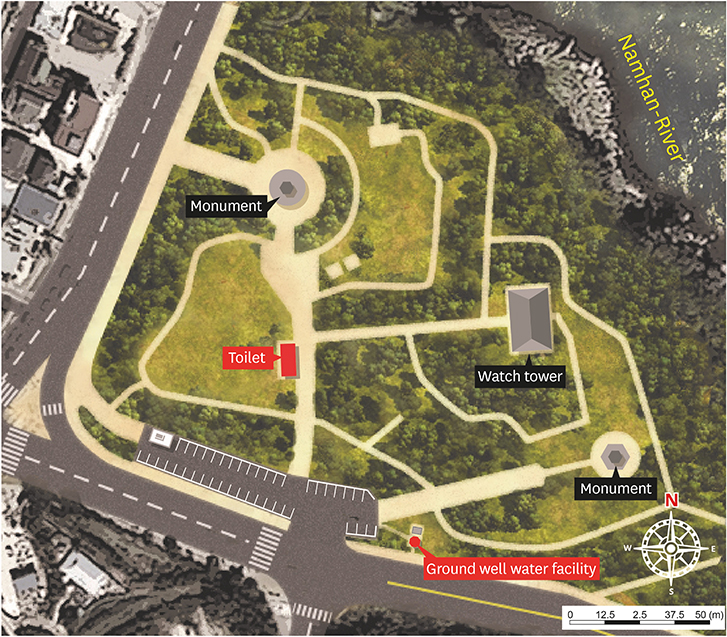Infect Chemother.
2019 Mar;51(1):62-66. 10.3947/ic.2019.51.1.62.
Hepatitis A Virus Infection from a Contaminated Tap of Ground Water Facility in a Neighborhood Park, Republic of Korea
- Affiliations
-
- 1Division of Infectious Disease Control, Gyeonggi Provincial Government, Suwon, Korea. gentryu@onehealth.or.kr
- 2WHO Collaborating Centre for Infectious Disease Epidemiology and Control, School of Public Health, Li Ka Shing Faculty of Medicine, The University of Hong Kong, Hong Kong, China.
- 3Institute for Occupational and Environmental Health, Korea University, Seoul, Korea.
- 4Division of Infectious Disease Control, City Public Health Center, Yeoju, Korea.
- 5Division of Infectious Diseases, Korea University College of Medicine, Seoul, Korea.
- KMID: 2442224
- DOI: http://doi.org/10.3947/ic.2019.51.1.62
Abstract
- A patient with Hepatitis A virus (HAV) infection was notified to the public health authority. The identical HAV was found at a water dispensing outlet at the ground water facility and the toilet close to the facility. Serosurveillance in the community was conducted. Suspicious individuals were asked to visit city public health center and had a serologic test for anti-HAV Ig M. Overall, 100 individuals were tested, and all were negative for the anti-HAV Ig M. In our study cohort, we could not identify additional case of HAV infection.
Keyword
MeSH Terms
Figure
Reference
-
1. Heymann DL. Control of communicable diseases manual. 19th ed. New York, USA: American Public Health Association;2008. p. 278–279.2. McCaustland KA, Bond WW, Bradley DW, Ebert JW, Maynard JE. Survival of hepatitis A virus in feces after drying and storage for 1 month. J Clin Microbiol. 1982; 16:957–958.
Article3. Bergeisen GH, Hinds MW, Skaggs JW. A waterborne outbreak of hepatitis A in Meade County, Kentucky. Am J Public Health. 1985; 75:161–164.
Article4. Serres GD, Theresa LC, Benoit L, Nicole B, Christine B, Marc D, Prud'homme H, Paradis D, Shapiro CN, Nainan OV, Margolis HS. Molecular confirmation of hepatitis A virus from well water: epidemiology and public health implications. J Infect Dis. 1999; 179:37–43.
Article5. Korea Centers for Disease Control and Prevention (KCDC). Infectious Disease Surveillance Yearbook, 2016. Osong: KCDC;2017.6. Korea Centers for Disease Control and Prevention. Detection of hepatitis A virus in a water supply facility in Yeongwol Neighborhood Park, Yeoju City. Accessed 23 June, 2018. Available at: http://www.cdc.go.kr/CDC/notice/CdcKrIntro0201.jsp?menuIds=HOME001-MNU1154-MNU0005-MNU0011&fid=21&q_type=title&q_value=%EC%97%AC%EC%A3%BC&cid=73195&pageNum=.7. Roche Diagnostics. Total antibodies (IgM and IgG) to the hepatitis A virus. Accessed 23 June, 2018. Available at: https://usdiagnostics.roche.com/products/05524261160/PARAM973/overlay.html.8. Noh DN, Park HJ, Cheong JY, Hamm SY. Groundwater recharge analysis and comparison using hybrid water-table fluctuation method and groundwater modeling: a case of Gangcheon basin in Yeoju City. J Geol Soc Korea. 2018; 54:169–181.
Article9. Shin E, Kim JS, Oh KH, Oh SS, Kwon M, Kim S, Park J, Kwak HS, Chung GT, Kim CJ, Kim J. A waterborne outbreak involving hepatitis A virus genotype IA at a residential facility in the Republic of Korea in 2015. J Clin Virol. 2017; 94:63–66.
Article10. Park IJ, Lee WG, Lim YA, Lee PO. Sero-positivity of anti-HAV IgG in young hospital workers. Korean J Blood Transfus. 2010; 21:43–49.11. Park SH. Hepatitis A: past and present. J Korean Med Assoc. 2009; 52:996–1004.
Article12. Korean Statistical Information Service. Population by type of use of drinking water. Accessed 23 June, 2018. Available at: http://kosis.kr/statHtml/statHtml.do?orgId=101&tblId=DT_1PH1008.13. Jo AH, Choi HN, Heo DB, Kwon SM, Kim JB. Prevalence and toxin characteristics of Bacillus cereus isolated from drinking cups in spring. J Food Hyg Saf. 2017; 32:50–56.
Article14. Ministry of Government Legislation. Regulations on water quality standards and inspection for drinking water Article No. 4. Accessed 23 June, 2018. Available at: http://www.law.go.kr/%EB%B2%95%EB%A0%B9/%EB%A8%B9%EB%8A%94%EB%AC%BC%EC%88%98%EC%A7%88%EA%B8%B0%EC%A4%80%EB%B0%8F%EA%B2%80%EC%82%AC%EB%93%B1%EC%97%90%EA%B4%80%ED%95%9C%EA%B7%9C%EC%B9%99.15. Centre for Health Protection. Health advice on using drinking fountains. Accessed 2 December, 2018. Available at: https://www.chp.gov.hk/files/pdf/guidelines_on_use_of_drink_fountain_public.pdf.
- Full Text Links
- Actions
-
Cited
- CITED
-
- Close
- Share
- Similar articles
-
- Analysis of Contaminated Ground Water Inducing Methemoglobinemia and Epidemiologic Investigation of Contaminated Ground Water
- Epidemiologic investigation to identify the cause of an infant methemoglobinemia
- Prevention of Viral Hepatitis and Vaccination
- The role of domestic tap water in Acanthamoeba contamination in contact lens storage cases in Korea
- Contributing Factors of Infectious Waterborne and Foodborne Outbreaks in Korea


